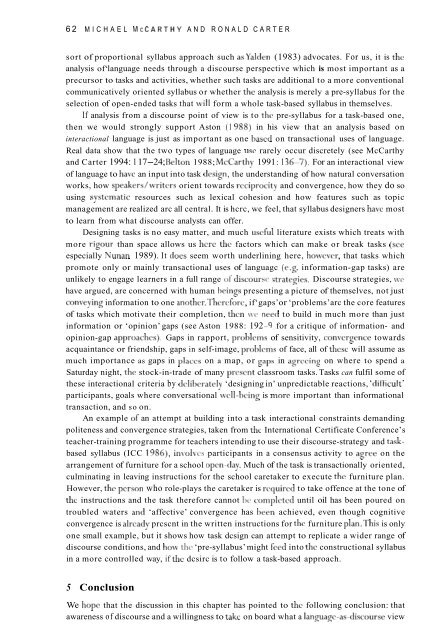Download - Search
Download - Search
Download - Search
You also want an ePaper? Increase the reach of your titles
YUMPU automatically turns print PDFs into web optimized ePapers that Google loves.
62 MICHAEL MCCARTHY AND RONALD CARTERsort of proportional syllabus approach such asYalden (1983) advocates. For us, it is theanalysis of‘ language needs through a discourse perspective which is most important as aprecursor to tasks and activities, whether such tasks are additional to a more conventionalcommunicatively oriented syllabus or whether the analysis is merely a pre-syllabus for theselection of open-ended tasks that will form a whole task-based syllabus in themselves.If analysis from a discourse point of view is to the pre-syllabus for a task-based one,then we would strongly support Aston (1 988) in his view that an analysis based oninteractional language is just as important as one based on transactional uses of language.Real data show that the two types of language use rarely occur discretely (see McCarthyand Carter 1994: 117-24; Iklton 1988; McCarthy 1991 : 136--7). For an interactional viewof language to have an input into task dcsign, the understanding of how natural conversationworks, how speakers/writers orient towards rcciprocity and convergence, how they do sousing systcmatic resources such as lexical cohesion and how features such as topicmanagement are realized arc all central. It is hcrc, we feel, that syllabus designers have mostto learn from what discourse analysts can offer.Designing tasks is no easy matter, and much useful literature exists which treats withmore rigour than space allows us hcrc thc factors which can make or break tasks (seeespecially Nunan 1989). It does seem worth underlining here, howcvcr, that tasks whichpromote only or mainly transactional uses of languagc (e.g. information-gap tasks) areunlikely to engage learners in a full range 01’ discour. trategies. Discourse strategies, wehave argued, are concerned with human heings presenting a picture of themselves, not justconveying information to one anothcr.Thcrcforc, if‘gaps’ or ‘problems’ arc the core featuresof tasks which motivate their completion, thcn we need to build in much more than justinformation or ‘opinion’ gaps (see Aston 1988: 192 -9 for a critique of information- andopinion-gap approachcs). Gaps in rapport, prohlcms of sensitivity, convcrgrnce towardsacquaintance or friendship, gaps in self-image, problc~ms of face, all of these will assume asmuch importance as gaps in placcs on a map, or gaps in agrccing on where to spend aSaturday night, the stock-in-trade of many prcscnt classroom tasks. Tasks can fulfil some ofthese interactional criteria by dclibcrately ‘designing in’ unpredictable reactions, ‘diflicult’participants, goals where conversational well-king is morc important than informationaltransaction, and so on.An example of an attempt at building into a task interactional constraints demandingpoliteness and convergence strategies, taken from the International Certificate Conference’steacher-training programme for teachers intending to use their discourse-strategy and taskbasedsyllabus (ICC 1986), involl participants in a consensus activity to agrce on thearrangement of furniture for a school opcn-day. Much of the task is transactionally oriented,culminating in leaving instructions for the school caretaker to execute the furniture plan.However, the person who role-plays the caretaker is required to take offence at the tone ofthe instructions and the task therefore cannot be complctcd until oil has been poured ontroubled waters and ‘affective’ convergence has been achieved, even though cognitiveconvergence is already prcscnt in the written instructions for the furniture plan.This is onlyone small example, but it shows how task dcsign can attempt to replicate a wider range ofdiscourse conditions, and how the ‘pre-syllabus’ might fecd into thc constructional syllabusin a more controlled way, if the dcsirc is to follow a task-based approach.5 ConclusionWe hope that the discussion in this chapter has pointed to the following conclusion: thatawareness of discourse and a willingness to take on board what a language-as~discourse view


